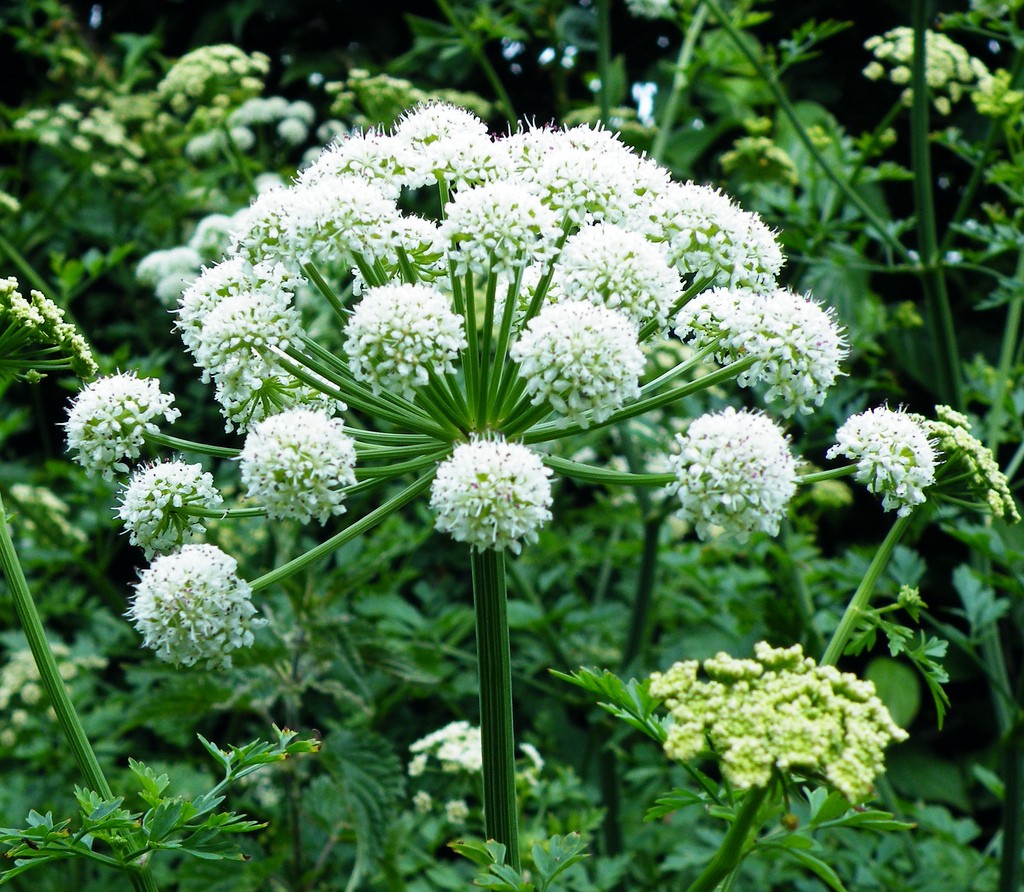| |
Angelica Root (Angelica archangelic)
 |
Angelica archangelica, commonly known as garden angelica, wild celery, and Norwegian angelica, is a biennial plant from the Apiaceae family, a subspecies of which is cultivated for its sweetly scented edible stems and roots. Like several other species in Apiaceae, its appearance is similar to several poisonous species (Conium, Heracleum, and others), and should not be consumed unless it has been identified with absolute certainty. Synonyms include Archangelica officinalis Hoffm., and Archangelica officinalis var. himalaica C.B.Clarke.
During its first year it grows only leaves, but, during its second year, its fluted stem can reach a height of 2.5 meters (just over 8 feet), from that stem the root, which is used in medicinal preparations. Its leaves comprise numerous small leaflets divided into three principal groups, each of which is again subdivided into three lesser groups. The edges of the leaflets are finely toothed or serrated. The flowers, which blossom in July, are small and numerous, yellowish or greenish, are grouped into large, globular umbels which bear pale yellow, oblong fruits. Angelica grows only in damp soil, preferably near rivers or deposits of water.
Angelica archangelica grows wild in Russia, Finland, Sweden, Norway, Denmark, Greenland, the Faroe Islands, and Iceland, mostly in the northern parts of the countries. It is cultivated in France, mainly in the Marais Poitevin, a marsh region close to Niort in the department Deux-Sèvres. Commercially available sources of angelica are often sourced from Hungary, Romania, Bulgaria, Germany and Poland. Some Angelica is sourced from Asia as well, though it may be confused with similar plants like Angelica Glauca, which are also sometimes sold simply as Angelica.
Angelica (A. archangelica) essential oil in clear glass vial
From the 10th century on, angelica was cultivated as a vegetable and medicinal plant, and achieved popularity in Scandinavia in the 12th century and is still used today, especially in Sami culture. Angelica is a shamanic medicine among the Saami or Laplanders.
A flute-like instrument with a clarinet-like sound can be made of its hollow stem. Linnaeus reported that Sami peoples used it in reindeer milk,[citation needed] as it is often used as a flavouring agent.
In 1602, angelica was introduced in Niort, which had just been ravaged by the plague.[dubious – discuss] It is used to flavour liqueurs or aquavits, (e.g., Chartreuse, Bénédictine, Vermouth, and Dubonnet), omelettes and trout, and as jam. The long bright-green stems are also candied and used as decoration.
John Gerard's Herball praises the plant and states that "it cureth the bitings of mad dogs and all other venomous beasts".
Angelica is unique amongst the Umbelliferae for its pervading aromatic odour, a pleasant perfume entirely different from fennel, parsley, anise, caraway, or chervil. It has been compared to musk and to juniper. Even the roots are fragrant, and form one of the principal aromatics of European botanical origin.
Angelica archangelica roots have been used in the traditional Austrian medicine internally as tea or tincture for treatment of disorders of the gastrointestinal tract, respiratory tract, nervous system, and also against fever, infections, and flu.[5] The roots are also among the most common botanicals used in gin distillation, often used in concert with Juniper berries and coriander as gin's chief aromatic accord. They are also used in absinthes, aquavits, and bitters, in addition to culinary uses such as jams and omelettes.
The hollow stems of Angelica archangelica are also eaten. The stems are picked clean of their leaves, crystallized in sugar syrup and colored green as cake decoration or as candy.
The fruits are tiny mericarps and are used in the production of absinthes, gins, and other alcoholic drinks. Seeds of a Persian spice plant known as Golpar (Heracleum persicum) are often mislabeled as "angelica seeds," and are not true seeds of Angelica archangelica.
Chemistry
The essential oil content of angelica root varies based on the age of the roots. Generally, the roots have high levels of terpenes, including α-pinene and β-phellandrene. Studies have found upwards of over eighty different aroma compounds present in samples. Of particular interest to perfumers and aroma chemists is Cyclopentadecanolide, which although present in small quantities (< 1% in roots, <.5% in seeds), it's primarily responsible for angelica root's distinctive musky aroma and was originally found in the roots.
Though the essential oil yield of Angelica seeds are slightly higher, it's the roots which are generally preferred for culinary and aroma uses.
Angelica seeds have a similar chemical composition to the roots, including α-pinene, β-pinene, camphene, myrcene, β-phellandrene, limonene, caryophyllene, borneol, carvone and others.
Both the seeds and roots contain coumarins and furocoumarins. Among these are 2′-angeloyl-3′-isovaleryl vaginate, archangelicin, oxypeucedanin hydrate, bergapten, byakangelicin angelate, imperatorin, isoimperatorin, isopimpinellin, 8-[2-(3-methylbutroxy)-3-hydroxy-3-methylbutoxy]psoralen, osthol, ostruthol, oxypeucedanin, phellopterin, psoralen and xanthotoxin, can be isolated from a chloroform extract of the roots of A. archangelica[11] as well as several heraclenol derivatives.[12] The water root extract of A. archangelica subsp. litoralis contains adenosine, coniferin, the two dihydrofurocoumarin glycosides apterin and 1′-O-β-d-glycopyranosyl-(S)-marmesin (marmesinin), 1′-O-β-d-glucopyranosyl-(2S, 3R)-3-hydroxymarmesin and 2′-β-d-glucopyranosyloxymarmesin.
Etymology
Archangelica comes from the Greek word "arkhangelos" (=arch-angel), due to the belief that it was the archangel Michael who told of its use as medicine.
In Finnish it is called väinönputki, in Kalaallisut kuanneq, in Northern Sami fádnu, boska and rássi, in English garden angelica, in German Arznei-Engelwurz or Echte Engelwurz, in Dutch grote engelwortel, in French angélique, in Persian Sonbol-e Khatāyi سنبل خطایی, in Swedish kvanne, in Norwegian kvann, in Danish kvan, in Icelandic hvönn, in Polish arcydziegiel, angelika, dzięgiel lekarski, dzięgiel wielki, anielskie ziele, archangielski korzeń, anielski korzeń, and in Faroese it has the name hvonn.
Health and Skin Benefits:
Angelica root oil is extremely beneficial for relieving pain associated with muscle aches and cramps. It produces relaxing effect on the body, helps relieve headaches, flatulence, fatigue, and nervous tension. Angelica root oil acts as a skin purifier, and great to be included in cleansing skin products and clay masques, as it removes toxins from the skin, as well as excess salt and water. It normalized oil production in skin. It is extremely beneficial for conditions such as rheumatism and arthritis. Angelica root oil is great for aromatherapy, and can provide relief for various conditions. This oil has a relaxing effect on the body, the mind, and the nervous system. This becomes particularly beneficial for depression, anxiety, and anger. In hair care, Angelica root can stimulate hair follicles for longer, more beautiful hair. Being anti-bacterial, Angelica is very helpful in cases of infections, and spreads up wound healing. It can be helpful for those who suffer from eczema and psoriasis.
Angelica root oil possesses a vast therapeutic repertoire; it is a revered ancient remedy, restorative, revitalizing, comforting, and promotes overall well-being. Angelica root oil supports winter wellness and vitality, as well as improved energy levels.
Angelica can also assist in the revitalization of dull, congested skin by encouraging healthy microbial balance. The characteristic spicy, musky odor of Angelica serves double duty as a key ingredient in perfume blending.
Word of Caution: It should be avoided during pregnancy and by diabetics. It can cause skin irritation in higher concentrations and also photo-toxicity. Higher doses of this oil can cause excessive stimulation or hyperactivity of the nervous system.
Blending: The essential oil of Angelica blends well with basil, chamomile, geranium, grapefruit, lavender, lemon, mandarin, and patchouli essential oils.
Referencess: https://en.wikipedia.org/wiki/Angelica_archangelica
Disclaimer: The information presented herein is intended for educational purposes only. These statements have not been evaluated by the FDA and are not intended to diagnose, cure, treat or prevent disease. Individual results may vary, and before using any supplements, it is always advisable to consult with your own health care provider.
|
|


















